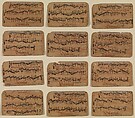Returned to lender The Met accepts temporary loans of art both for short-term exhibitions and for long-term display in its galleries.
Suit of Hearts, from The Playing Cards of Peter Flötner
Peter Flötner German
Publisher Hans Christoph Zell German
Not on view
The Playing Cards of Peter Flötner
Compared to many of his contemporaries, Peter Flötner produced relatively few woodcuts, but included among them is the most arresting deck of cards made in post-Reformation Germany. The cards were hand painted and enhanced with gold. The backs of the cards are inscribed with musical notations and lyrics, with each suit given a particular voice: Acorns, bass; Leafs, tenor; Hearts, treble; and Bells, alto. Each suit is headed by men alone: a king, an upper knave, and an under knave. The suits each have loose thematic connections. In Acorns, five of the pip cards deal with the scatological antics of pigs, which in popular culture were equated with gluttony and lust. In Leafs, several scenes are devoted to the capers of farmers or peasants, underscoring their reputation for drunken and licentious behavior. Hearts are concerned primarily with the pastimes of the bourgeoisie and the lack of chastity. And in Bells, a number of scenes address folly, vanity, and the futility of foolish behavior. The droll lucidity of his images is a pungent reminder that card playing spawns all types of sin, effectively justifying the denunciations of the clergy and civil authorities. But in another sense, these scenes may be seen as the final flourish of imagery that developed out of the monstrous, bawdy, topsy-turvy drolleries that abound in the marginalia of fourteenth-century manuscripts. In the crude subject matter of the cards, Flötner acknowledged man’s baser instincts while warning against them. These striking cards bring to life a microcosmic view of a world long gone while animating social and moral themes that still resonate today. More than any other artist, Flötner fully exploited the conceit of playing cards as a visual polemic to convey his worldview.
Suits: Acorns, Leafs, Hearts, and Bells
12 cards in each suit: King, Upper Knave, Under Knave, Banner (10), 9 through 2
48 cards, of which 47 survive
Germanisches Nationalmuseum, Nuremberg (GMN Sp 7418 1-47 Kapsel 516)
2 of Hearts
The card has a heraldic shield bearing the arms of the d’Este family of Ferrara.
King of Hearts
The king is costumed as a Turkish sultan; the dead children at his feet were a conventional way of conveying the perceived cruelty of the Turks as well as recalling the biblical stories of Herod and the Massacre of the Innocents.
Upper Knave of Hearts
The Upper Knave is a cupbearer.
Under Knave of Hearts
The Under Knave is a butcher with a lamb (?) slung over his back.
Banner (10) of Hearts
A seated lady with a dog holds the banner.
8 of Hearts
A woman with a sausage on her nose attempts to attract a young gentleman.
7 of Hearts
A pregnant woman holds up a convex mirror to two gentlemen; two fools appear in the reflection.
9 of Hearts
A naked child plays with two dogs.
6 of Hearts
A mercenary holds a banner.
5 of Hearts
Two young lovers meet at a fountain, a refreshingly innocent encounter.
4 of Hearts
A woman bends over, exposing her rear, and expels with sufficient force to knock her husband off his stool.
3 of Hearts
Two women attack a young man with a pitchfork and distaff, the unwelcome consequence of an illicit entanglement.
Due to rights restrictions, this image cannot be enlarged, viewed at full screen, or downloaded.
This artwork is meant to be viewed from right to left. Scroll left to view more.














